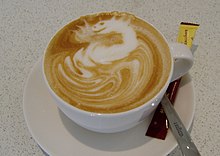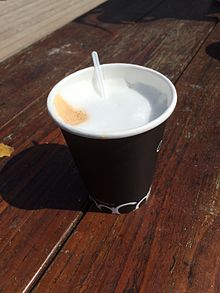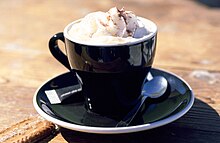cappuccino
Cappuccino ( Italian [ kapːuˈtːʃiːno ]; German [ ˌkapʊˈtʃiːno ], literally: capuchin ) is an Italian coffee drink that is prepared from an espresso and hot milk foam .
It is usually served in thick, preheated cups made of stoneware or porcelain and drunk sweetened. In Italy it is almost exclusively taken for breakfast , at least before lunch .
In Germany , the cappuccino became one of the most popular coffee drinks. Around 2006/2007, 16% of Germans consumed cappuccino at least once a week.
History of origin, origin of name and plural formation
Cappuccino is based on the Austrian Kapuziner , a Viennese coffee specialty. This is a mocha that is mixed with liquid whipped cream, which gives the drink a color that is reminiscent of the habit of a capuchin . Accordingly, the cappuccino gets its name from the diminutive (ending -ino ) of the Italian word for hood ( cappuccio ).
Cappuccino probably originated when Austrian soldiers stationed in Italy wanted to continue drinking their usual capuchin. Over time, today's cappuccino developed from this, which has little in common with its original form. In Austria, the two coffee specialties Kapuziner and Cappuccino now exist side by side on an equal footing.
The Duden gives “cappuccinos” as a plural form. As a loan word , it is treated like a German word. The Italian plural is “cappuccini”.
preparation
The Italian way of making cappuccino is with an espresso of around 25–30 ml in a 120–180 ml cup, which is quickly poured with semi-liquid, creamy milk foam until the cup is full. When the milk foam is poured in, the brown crema of the espresso settles above the foam and gives the cappuccino its characteristic appearance.
Milk foam
Outside Italy it is often wrongly assumed that the name cappuccino is derived directly from the Italian word for “hood” and refers to the milk foam hood. This often leads to the misconception that a “real” cappuccino must be served with a pointed “hood” or “pointed cap” made of firm milk foam. In the original (Italian) method of preparation, however, the milk foam is almost liquid when poured, free of noticeable air bubbles and the consistency of about half-whipped cream. When frothing, the milk should therefore not be heated above 70 ° C, otherwise the foam can easily become too firm and the cappuccino can also take on the taste of boiled milk.
The rule of thirds, according to which a cappuccino must consist of a third espresso, a third milk and a third milk foam, is relatively nonsensical, since milk and milk foam are not put into the cup separately, but together. After a short time, the two separate beneath the white-brown hood, so that a layer of foam of around 1 to 2 cm remains with a good cappuccino.

Cappuccino with latte art motif "fern leaf" (also "tree" or "rosetta" )
|
Due to the liquid consistency of the milk foam, a multitude of brown-graduated patterns, the so-called latte art, can be created by moving the jug when pouring the milk foam . More classic shapes are the heart or the leaf, more advanced shapes are for example tulip, dragon or butterfly. Every year there are numerous national and international competitions among baristi in the discipline of latte art.
Some coffee bars use cocoa powder or cinnamon to touch up the color and aroma of the creme topping on the milk, and sometimes even stencils to create patterns similar to the latte art. Sprinkling with cocoa is by no means common. The pattern and the taste of the brown bonnet are created according to the "puristic" method of preparation by mixing the crema with the poured milk foam, not by adding cocoa or the like.
Type of bean
Traditionally, no pure Arabica coffee is used as the bean mixture, but a mixture with a proportion of Robusta beans. The classic mix of Italian caffè bars has an Arabica / Robusta ratio of 60/40, but there are also more and more mixes with little or no Robusta content, especially in northern Italy. Contrary to its reputation as an “unrefined” coffee bean, however, the Robusta is particularly advantageous when preparing cappuccino: On the one hand, its flavor prevails better in the milk mix drink than Arabica, which tends to be more acidic, on the other hand, the Robusta produces more crema during extraction, which is a good thing provides a stronger color of the brown hood. Especially outside of Italy, however, there are now more and more sophisticated coffee bars that emphasize that they only work with pure Arabica blends.
Variations
With cream
In Austria, the Italian version of cappuccino is mainly served, i.e. with milk foam. The variant sometimes found in Germany with whipped cream instead of frothed milk is known in Austria as Franziskaner , in Italy as cappuccino con panna .
With flavors, syrup etc.
The cappuccino is the basis for all kinds of new creations by the modern coffee house chains. In many cafés it is offered as "Flavored Cappuccino" and then flavored with various syrups or other additives. Primarily used several are in chocolate - walnut - vanilla - or caramel - flavors chosen more unusual combinations such. B. the addition of pieces of fruit or marshmallows . In addition, versions with ice cubes or crushed ice are also offered in summer, which are supposed to have a particularly refreshing effect.
In numerous new creations, the naming uses parts of the word cappuccino. So z. B. a cappuccino made from ordinary filter coffee, which was otherwise prepared just like regular cappuccino, also called caffecino . There are now even protected brand names, such as Chococino (a cocoa drink with milk foam) from the food company Nestlé .
See also
- Latte macchiato
- Caffè Shakerato
- Melange
- Cappuccino effect via a physical phenomenon in cappuccino
Web links
- PM article on the origin of the cappuccino ( Memento from June 27, 2006 in the Internet Archive )
- Information and video on how to prepare cappuccino ( Memento from December 15, 2016 in the Internet Archive )
Individual evidence
- ↑ enjoyment incidence of cappuccino , typology of desires 2006/2007



